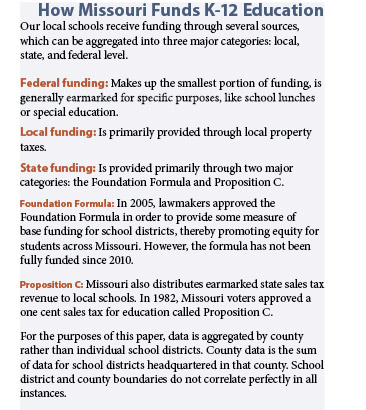Investing in Our Students’ Futures 
Download the PDF of Investing in Our Students
Missourians want to give our children the best possible chance at success. We want our children to have quality public schools that start them off right towards pursuing their dreams.
Unfortunately, the state of Missouri is failing to meet its obligation to more than 820,000 K-12 students by shortchanging school funding. As a result, the burden for ensuring school funding is increasingly shifting to localities, setting the stage for enhanced funding disparities between school districts.
- In the current school year, the amount of funding provided through Missouri’s “Foundation Formula”, which distributes state support to local schools, remains $400 million under the statutorily required level.1
- Had state funding increased at the same rate as inflation between the 2001 and 2014 school years, state funding would have been $361 million greater in FY 2014.2 That’s the equivalent of our local schools having an additional $554 per student to enhance educational opportunities.
- Local governments have tried to make up the difference, resulting in property tax rate increases in 92 percent of counties in Missouri. Rates have risen an average 11.5%.
- But not every local government can or will make up for the state’s lack of funding. In one of four Missouri counties, total funding per student has failed to keep pace with the increased cost of providing education since 2000.
- In the 2013-2014 school year, total funding per student already varied significantly with St. Louis County averaging 75 percent more in total funding per student compared to St. Francois County.
All of Missouri’s children deserve an opportunity to thrive. A solid education is a fundamental building block to a better future. We can – and must – do better by fully funding our local schools.
The Value of State Funding is Declining
 Although the combined amount of the Foundation Formula and Proposition C revenue for local schools has increased over time, it has failed to keep pace with inflation and the growing costs of funding education.Although the combined amount of the Foundation Formula and Proposition C revenue for local schools has increased over time, it has failed to keep pace with inflation and the growing costs of funding education. Between the 2000-2001 and 2013-2014 school years, state funding for local schools increased by 22.7 percent. However, that growth rate fell well below the inflation rate over the same period of 34 percent. As a result, the real value of state funding has declined.
Although the combined amount of the Foundation Formula and Proposition C revenue for local schools has increased over time, it has failed to keep pace with inflation and the growing costs of funding education.Although the combined amount of the Foundation Formula and Proposition C revenue for local schools has increased over time, it has failed to keep pace with inflation and the growing costs of funding education. Between the 2000-2001 and 2013-2014 school years, state funding for local schools increased by 22.7 percent. However, that growth rate fell well below the inflation rate over the same period of 34 percent. As a result, the real value of state funding has declined.
Had state funding increased at the same pace as the inflation rate (as measured by the Consumer Price Index), state funding would have been $361 million greater in FY 2014.
State Funding Failing to Meet Inflationary Needs
The school population increased by nearly 18,000 students over this same period, making the decline in the value of state funding more pronounced.3 While state funds increased an average of $799 per student, when that amount is adjusted for inflation, the purchasing power in 2013-2014 was $554 per student below the level provided in 2000-2001.4
- In five out of every six counties, the amount of state funding provided per student failed to meet inflationary cost increases.
- Moreover, in four counties (St. Louis City, Knox, Morgan, and Chariton), the amount of state funding actually decreased in nominal dollars over this period. In only 18 of 115 counties did state funding meet or exceed inflationary needs on a per-student basis.
Passing the Buck
As the value of state funding has declined, local governments have shouldered an increased burden for funding education. While Missouri provided 48 percent of total funding for its schools in the 2000-2001 school year, by 2013-2014, its contribution had declined to 41 percent. Conversely, local revenue as a portion of funding increased from 45 to 50 percent over this same period.
Increased Property Taxes and Disparities in Funding for Education
To compensate for the decline in the value of state funding, Missouri schools have shifted to a greater reliance on local property tax revenues to fund education. As a result, over thirteen years, local property tax rates to fund schools increased in 92 percent of counties, rising by an average of 11.5 percent. 
Only six counties decreased their property taxes during this time, and three maintained their rates.5
Unfortunately, while some school districts have been able to address decreasing state funding by leveraging increased property values, districts with low property values – including many rural school districts – struggle to adequately fund local schools. In fact, even with property tax levy increases in most counties, the total amount of state, local, and federal funding combined per student failed to keep pace with inflation in 31 counties over the time period examined. In other words, in one out of every four Missouri counties, total funding per student failed to keep pace with the cost of providing education.
 The shifting burden of funding education could result in increasing a troubling disparity in education funding among school districts. In the 2013-2014 school year, the combined per student revenue available varied significantly among school districts – from a low of $8,968 in St. Francois County to a high of $15,778 in St. Louis County. Significant disparity in funding exists within each county as well, which is not addressed in this analysis.
The shifting burden of funding education could result in increasing a troubling disparity in education funding among school districts. In the 2013-2014 school year, the combined per student revenue available varied significantly among school districts – from a low of $8,968 in St. Francois County to a high of $15,778 in St. Louis County. Significant disparity in funding exists within each county as well, which is not addressed in this analysis.
Missouri must do better and fulfill its responsibility to students across the state.


